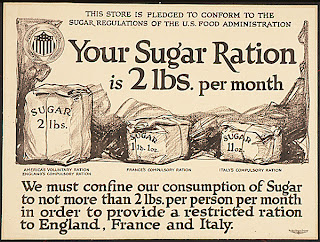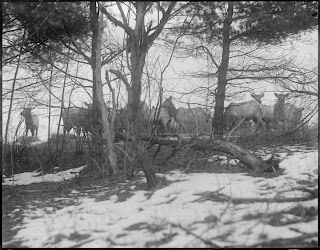 |
| Photos courtesy of the Boston Public Library, Leslie Jones Collection |
Wednesday, May 25, 2011
Tuesday, May 24, 2011
Feeding the Elk, 1926
 |
| Photos courtesy of the Boston Public Library, Leslie Jones Collection |
The elk on the Nemasket Elk Range were enclosed by a mesh and barbed wire perimeter fence as seen in the photographs here. Though it was intended that the elk would forage on the extensive range, supplemental food including possibly dairy feed was provided with the animals being fed from large metal basins. Initially visitors were permitted to watch the animals being fed from outside the fence, though this was later discouraged. The woman captured hand feeding the elk is Lillian ("Lill") M. Jones, wife of Percy R. Jones, one of the proprietors of the elk range.
Monday, May 23, 2011
Unloading Elk, 1926
 |
| Photos courtesy of the Boston Public Library, Leslie Jones Collection |
In February, 1926, large numbers of elk began arriving on the Nemasket Elk Range, transported from the Middleborough railroad depot in enclosed trucks. The first two photos capture antler-less bucks being unloaded, their horns having been removed for the safety of the animal during transport. The man on the right appears to be Percy R. Jones. Does were brought in groups to the range, as illustrated by the remaining images.
Sunday, May 22, 2011
Mr. & Mrs. Percy Jones, c. 1926
 |
| Courtesy of the Boston Public Library, Leslie Jones Collection. |
Friday, May 13, 2011
Wealthy Middleborough, 1774
The Brockton Weekly Gazette carried the following interesting item on July 16, 1874, regarding the Revolutionary-era wealth of Middleborough: "One hundred years ago, Middleboro stood the twelfth town in the state in the amount of its assessment, exceeding that of Taunton, Roxbury, Charlestown and Cambridge." The town's extensive agricultural development and the presence of the Oliver iron works attributed to the high assessment.
Saturday, May 7, 2011
Nemasket Automobile Company, 1911-42
 |
Nemasket Automobile Company, Middleborough MA, stock certificate, early 1900s |
The Nemasket Auto Company was established on April 3, 1911, with John W. Howes (1850-1926) as president, Howes’ son John G. Howes (1887-1971) as treasurer and manager, and William L. Whittier. The younger Howes and Whittier both had previously been employed by Carlton W. Maxim’s Middleboro Auto Exchange. The Exchange was a retailer, repairer and lessor of automobiles and was later affiliated with the Maxim Motor Company which at that time had yet entered the field of fire apparatus manufacturing and still engaged strictly in automotive sales and repairs. John W. Howes appears to have been involved in the Nemasket Automobile Company primarily as financier to the operation and probably had little day-to-day involvement with the conduct of the firm which came to include three of his other children. Whittier died shortly after the establishment of the firm and was succeeded by Harry W. Howes (1886-1970), Bernard Howes (1893-1979), and Miss Alice Howes (1890-1952) who also assumed the role of office manager in 1927.
 |
Hudson "33" advertisement, Hudson Motor Car Company, 1911 One of the first vehicles sold by the Nemasket Automobile Company following its opening in April, 1911, was a Hudson "33". |
 |
Nemasket Automobile Company Premises, plan by Mike Maddigan |
To keep alert to the latest developments in the automotive field, John G. Howes frequently attended functions sponsored by the Hudson Motor Car Company. In March, 1912, he attended the Hudson booths at the Boston automobile show, and in July, 1912, traveled to Detroit to view Hudson’s 1913 models including the Hudson “37” which Howes termed “the best ever”. Additionally, Nemasket Company mechanics were rigorously trained in the intricacies of Hudson-built machines with Hazell F. Norton attending a three-week training school for Hudson mechanics in Detroit in early 1913.
 |
Yale Motorcycle advertisement, mid 1910s |
 |
Hudson Brougham advertisement, Hudson Motor Car Company, 1925 |
Then, as now, automobile advertising was a fixture of the local newspaper, and the Nemasket Auto Company’s ads were a frequent fixture in the Middleboro Gazette.
 |
Hudson Coach advertisement, Hudson Motor Car Company, 1925 |
The fire proof construction of the building was tested at least twice during Nemasket’s tenure there. On the evening of July 22, 1918, “while supplying gasoline from a sentry to a motorcycle, in which the headlights were burning, the gasoline caught fire and this spread rapidly over the machine and the sentry. It was extinguished by a Pyrene tank almost before the [fire] department arrived.” Another fire on the morning of November 23, 1928, ignited from sparks from the chimney, setting the roof temporarily on fire. It was “quickly subdued by chemicals.”
As elsewhere, automobile sales in Middleborough were competitive and the town had its own 1920s equivalent of the modern day “auto mile” in the form of Wareham Street. In addition to the Nemasket Auto Company, Wareham Street was also home to Charles R. Chase’s Riverside Garage (Ford), the Maxim Motor Company (Overland) and the Howes & Perkins Garage (Chevrolet). A short distance away, Bailey’s Garage at Rice and Sproat Streets held the Buick, Peerless and G. M. C. truck agencies; W. L. Aller’s Studebaker Service Station at Everett Square sold Studebakers; the Triangle Auto Company on Vine Street held the agency for Reo automobiles for Middleborough, Lakeville, Bridgewater and Halifax; and H. H. Dunham’s Garage at the Lakeville Upper Four Corners sold Chandler cars, Cleveland cars and Walker-Johnson trucks.
 |
"Hudson's Great 8" advertisement, Hudson Motor Car Company, 1930 By 1930, Hudson and Nemasket were focused on advertising the company's latest 8-cylinder models. |
Additionally, the garage sought to promote its principal product through highly-advertised events and programs. One of these held on July 24, 1929, featured Irving D. Thompson of the Hudson Motor Car Company who presented a three-reel film at the garage followed by “a comprehensive lecture” on the chassis of the new Hudsons.
 |
Nemasket Automobile Company building, 15 Wareham Street, Middleborough, MA, photographed May 4, 2011 by Mike Maddigan Detail of garage ramp built on the site of the former Sparrow House. |
The Nemasket Auto Company remained in operation through 1942 when John G. Howes retired from the business. At that time, the company’s showroom and shop building on Wareham Street was acquired by Maxim Motors which relocated its sales and repair operations there. The building still stands at what is now 15 Wareham Street near Clifford Street.
Wednesday, May 4, 2011
Distributing Sugar, 1918
 |
Plymouth County Sugar Distribution Coupon, December, 1918 |
Unlike during World War II with its ration books and O. P. A. tokens, Middleborough America Plymouth County November 11, 1918 .
 |
| "Your Sugar Ration", U. S. Food Administration, Poster, 1917-18 |
Monday, May 2, 2011
Plymouth & Middleboro Railroad Preliminary Survey, 1889
As originally surveyed in 1889, the proposed route of the Plymouth & Middleboro Railroad between the Green at Middleborough and Darby in Plymouth was much different than the course finally accepted. Rather than running most of the way north of Plymouth Street as it ultimately did, the course of the railroad as originally surveyed crossed to the south side of Plymouth Street near Short Street in Middleborough, passed directly over Savery's Pond at Waterville, and ran to the south side of the North Carver Green. From there, the railroad would have been laid out in a large arc, running to the south of Wenham Pond in Carver before returning in a northerly direction to Darby Pond. It is likely that this proposal was dropped in favor of the route which was finally adopted for financial and strategic reasons. In contrast to the 1889 plan, the final route greatly reduced the number of grade crossings, eliminated the need for a causeway across or a bridge over Savery's Pond, and considerably reduced the trackage between North Carver and Darby by creating a more direct route. (To view the original preliminary survey in its entirety, click on the source reference below).
Source: "Map Showing the Lines of Preliminary Survey and Office Location Line of the Plymouth and Middleboro Railroad", James M. Hodge, Chief Engineer, 1889. Massachusetts State Library.
Subscribe to:
Comments (Atom)











































+of+Smoky+Mountains+018.jpg)